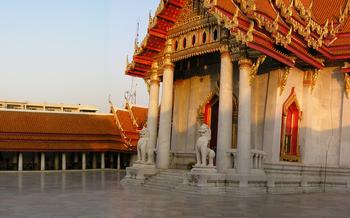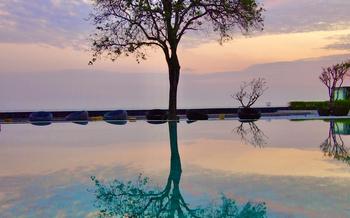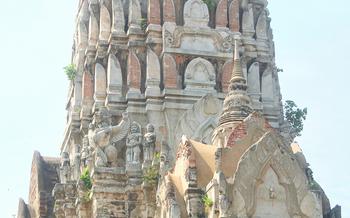
Wat Santi Wanaram
- Location and Accessibility
- The Bone Chapel
- The White Buddha
- The Ubosot
- The Sala Kan Parian
- The Crematorium
- The Meditation Center
- The Temple Museum
- The Temple School
- The Temple Market
- Insider Tip: Respectful Behavior
Location and Accessibility
Exact Address: Wat Santi Wanaram is situated at 162/1 Mittrapap Road, Mak Khaeng Sub-district, Mueang Udon Thani District, Udon Thani 41000, Thailand.
Getting There by Public Transport: - From Udon Thani Airport (UTH), take a taxi or Grab car to the temple. The journey should take approximately 20 minutes and cost around 200 THB. - Alternatively, catch a songthaew (shared taxi) from the airport to the city center and then transfer to another songthaew heading towards the temple. This option is more economical but may take longer.
Getting There by Private Transport: - If driving from Bangkok, take Highway 2 (Mittrapap Road) northeast towards Udon Thani. The temple is located approximately 570 kilometers from Bangkok and takes about 7 hours to reach by car.
Parking Availability: - Ample parking space is available within the temple grounds for both cars and tour buses. Parking is free of charge.
The Bone Chapel
The Bone Chapel, known as the Udon Thani's Temple of Bones, is a haunting yet fascinating sight that draws both awe and contemplation. Originally constructed as a meditation spot for monks to reflect on the impermanence of life, the chapel has become a symbolic reminder of the circle of life and the journey towards enlightenment.
- History and Purpose of the Chapel:
The Bone Chapel's origins can be traced back to the 19th century when a local abbot, Venerable Phra Kru Sutasee, initiated its construction as a place for meditation and contemplation. He believed that by surrounding themselves with reminders of death, monks could cultivate detachment and focus on their spiritual growth.
- Significance of the Human Remains:
The bones displayed in the chapel come from various sources, including deceased monks, villagers, and even criminals who sought redemption. Each bone is carefully cleaned, blessed, and arranged in a respectful manner, serving as a poignant reminder of the transient nature of human existence.
- Display and Presentation of the Bones:
The bones are arranged in various displays, creating a unique and thought-provoking environment. Skulls, long bones, and ribs form intricate patterns and structures, showcasing the human anatomy in its raw and unvarnished state. The chapel's dimly lit interior adds to the contemplative atmosphere, inviting visitors to reflect on the fragility of life.
- Ethical Considerations:
The use of human remains in the Bone Chapel raises ethical considerations. However, it's essential to understand that the bones are treated with utmost respect and reverence. Visitors are reminded to be mindful and respectful of the cultural and religious significance of the chapel, ensuring that they do not engage in disrespectful behavior or photography.
The White Buddha
History and Origins of the Buddha Statue The White Buddha, or Phra Phuttha Mongkhon Bophit, is one of the most striking and iconic features of Wat Santi Wanaram. The colossal statue towers over the temple grounds, exuding an aura of serenity and spirituality. It was built in 1958 by Luang Pu Khao, a renowned Buddhist monk and teacher. Luang Pu Khao had a vision of a large white Buddha statue that would bring peace and prosperity to Udon Thani. With the help of local artisans and craftsmen, he brought his vision to life, creating a masterpiece that has become a symbol of the temple and the city.
Symbolism and Iconography The White Buddha is a representation of the Buddha Shakyamuni, the founder of Buddhism. The statue is depicted in the classic seated meditation posture, with the right hand raised in the Abhaya mudra, a gesture of protection and reassurance. The left hand rests on the lap, symbolizing equanimity and detachment. The serene expression on the Buddha's face reflects his inner peace and compassion, inviting devotees to seek refuge in his teachings.
Cultural Significance and Reverence The White Buddha is deeply revered by the people of Udon Thani and is considered a sacred object of worship. It is believed to possess miraculous powers and has become a popular destination for pilgrims and devotees from all over the region. Many come to pray for good fortune, blessings, and protection. The statue is also a symbol of cultural pride and identity, representing the fusion of Buddhist teachings with local traditions and beliefs.
Prayer and Offerings Devotees often make offerings to the White Buddha as a way of expressing their gratitude and seeking blessings. These offerings can include flowers, incense, candles, and food. Some may also light joss sticks and recite mantras or prayers while meditating in front of the statue. The act of offering and praying to the White Buddha is believed to bring merit and purify the mind and heart, fostering spiritual growth and inner peace.
The Ubosot
The Ubosot, or ordination hall, is the most sacred structure within the temple complex. It is the site of important rituals and ceremonies, including ordinations, monkhood initiations, and Buddhist weddings. The Ubosot at Wat Santi Wanaram is a testament to the temple's architectural grandeur and religious significance.
-
Architectural Features and Decorations: The Ubosot's design follows traditional Thai temple architecture, featuring a rectangular layout with a steeply pitched roof adorned with intricate carvings and colorful ceramic tiles. The exterior walls are decorated with stunning murals depicting scenes from Buddhist mythology and the life of Buddha.
-
Buddha Images and Altars: Inside the Ubosot, the central attraction is the principal Buddha image, known as the Phra Ubosot. This majestic golden statue is seated in the traditional bhumisparsha mudra, or earth-touching gesture, symbolizing Buddha's enlightenment and his call to the earth goddess to witness his triumph over the forces of evil.
-
Rituals and Ceremonies: The Ubosot is the venue for various rituals and ceremonies throughout the year. Ordination ceremonies, where young men are formally initiated into the Buddhist monkhood, are significant events that draw many devotees and visitors. Monks chant sacred texts, offer blessings, and perform symbolic rituals during these ceremonies.
The Sala Kan Parian
The Sala Kan Parian is a multi-purpose pavilion located within the temple grounds, serving as a venue for various cultural events and activities. Its architectural design features intricate carvings and decorations, showcasing the artistic prowess of the local craftsmen. The sala is often used for traditional Thai dance performances, music concerts, and religious ceremonies. During festivals and special occasions, the sala transforms into a vibrant stage, where local artists and performers showcase their talents, creating a lively and festive atmosphere for visitors to enjoy. It is a place where the community comes together to celebrate their cultural heritage and traditions.
The Crematorium
The crematorium at Wat Santi Wanaram is a significant structure that serves as a final resting place for the deceased members of the temple community. Traditional cremation practices are still observed here, following centuries-old rituals and beliefs. The crematorium is a reminder of the cycle of life and death, and the importance of paying respect to the departed.
Symbolism and Rituals
Cremation in Thailand is not merely a means of disposing of the body but a sacred ritual steeped in symbolism and deep-rooted beliefs. The process begins with a bathing ceremony where the body is washed and adorned with flowers and incense. The body is then placed in a decorated coffin and carried in a procession to the crematorium, accompanied by chanting monks and mourners.
Cultural and Religious Beliefs
In Thai culture, cremation is seen as a way to release the spirit from the physical body and allow it to ascend to the afterlife. Cremation is also believed to purify the soul and free it from earthly attachments. The ashes of the deceased are collected and often placed in a stupa or reliquary within the temple grounds, as a way to honor their memory and keep their spirits close.
The Meditation Center
The Wat Santi Wanaram houses a serene and tranquil meditation center that offers visitors a sanctuary for inner peace and spiritual growth. The center provides a peaceful environment conducive to meditation, with dedicated meditation halls and experienced teachers who guide practitioners through various meditation techniques.
Whether you are a seasoned meditator or a beginner seeking to explore the practice, the center offers a range of meditation programs and workshops tailored to different needs and levels of experience. From guided meditation sessions to silent retreats, there are opportunities for both individual practice and group sessions.
The center's peaceful ambiance, surrounded by lush greenery and the soothing sounds of nature, creates an ideal setting for introspection and self-discovery. Visitors can embark on a transformative journey, delving deep into their inner selves to cultivate mindfulness, reduce stress, and find inner peace.
The Temple Museum
The Wat Santi Wanaram houses a small but intriguing temple museum that offers visitors a glimpse into the rich history and cultural heritage of the temple. The museum showcases a collection of artifacts, relics, and historical documents that tell the story of the temple's founding, its significance to the local community, and its place in the wider context of Thai history and culture.
Among the highlights of the museum's collection are ancient Buddha images, votive tablets, and other religious objects that have been found on the temple grounds. These artifacts provide valuable insights into the religious practices and beliefs of the people who have worshipped at the temple over the centuries. The museum also features a collection of historical photographs and documents that offer a glimpse into the temple's past, including its construction, renovations, and important events that have taken place within its walls.
The temple museum is a valuable resource for anyone interested in learning more about the history and significance of the Wat Santi Wanaram. It is a place where visitors can connect with the past and gain a deeper understanding of the cultural and religious traditions that have shaped this unique and fascinating temple.
The Temple School
The Wat Santi Wanaram Temple School is a cherished institution that has been nurturing young minds and preserving cultural traditions for generations. Founded with the noble intention of providing education and instilling moral values in the local community, the school has played an integral role in shaping the lives of countless individuals.
The school offers a comprehensive curriculum that encompasses both secular and religious subjects, ensuring that students receive a well-rounded education. Dedicated and experienced teachers guide students through various academic disciplines, fostering critical thinking, problem-solving skills, and a deep appreciation for knowledge.
In addition to academic pursuits, the school places great emphasis on preserving and transmitting cultural traditions. Students are immersed in the teachings of Buddhism, learning about its principles, practices, and rich history. They participate in traditional ceremonies, engage in meditation and chanting, and develop a profound understanding of their cultural heritage.
The Temple School also serves as a hub for community involvement, fostering a sense of unity and belonging among students, parents, and the wider community. It organizes various events, workshops, and festivals that celebrate local customs, promote cultural exchange, and strengthen the bonds between generations.
Through its dedication to education and the preservation of cultural traditions, the Wat Santi Wanaram Temple School stands as a beacon of learning and community spirit, leaving an indelible mark on the lives of those who pass through its doors.
The Temple Market
On the temple grounds, visitors can also explore the vibrant temple market, a bustling hub of activity where locals and tourists alike come together to shop, eat, and socialize. The market is typically held on weekends and offers a wide variety of goods and souvenirs, including handmade crafts, traditional clothing, and local delicacies. Visitors can also indulge in delicious street food from the many stalls that line the market, offering a taste of authentic Thai cuisine. It's a great place to find unique souvenirs and experience the local culture.
When shopping at the temple market, it's important to be respectful of the local customs and traditions. Bargaining is acceptable, but it should be done in a polite and respectful manner. Visitors should also be mindful of their behavior and avoid using offensive language or gestures. Supporting the temple market not only contributes to the local economy but also helps preserve the temple's cultural heritage.
Insider Tip: Respectful Behavior
When visiting Wat Santi Wanaram, it is essential to be mindful of your behavior and actions to show respect for the temple's sacredness and the local culture. Here are some guidelines to follow:
-
Dress Code and Etiquette: Dress modestly and appropriately when visiting the temple. Avoid wearing shorts, tank tops, or revealing clothing, as these may be considered disrespectful.
-
Avoid Offensive Actions or Language: Refrain from using foul language or engaging in behavior that could be deemed offensive or disrespectful to the temple, the monks, or the local people.
-
Show Respect to Monks and Locals: Monks are highly revered in Thai culture, so always show them respect by bowing your head or wai-ing (placing your hands together in a prayer-like gesture) when greeting them. When interacting with locals, be polite and respectful, and avoid making loud noises or causing disturbances.
-
Contribute to the Temple's Upkeep: If you wish to contribute to the temple's upkeep, you can make a donation to the temple donation box or purchase offerings such as flowers, candles, or incense. Your contribution will help maintain the temple's beauty and support the monks' livelihood.



